US Secretary of State Rex Tillerson stated that while Pakistan is ‘a sovereign country’ that can ‘decide what [it] wants to do’, if Pakistan was to deviate from Washington’s South Asia strategy, the United States would just ‘adjust [its] tactics and … strategies to achieve the same objective a different way’.
On 7 October, Secretary of Defense James Mattis echoed Indian concerns about the multi-billion dollar China–Pakistan Economic Corridor in a way never heard before: ‘the [Belt and Road Initiative] also goes through disputed territory, and I think that in itself shows the vulnerability of trying to establish that sort of a dictate’.
General Joseph Dunford, Chairman of the Joint Chiefs of Staff, separately told the House Armed Services Committee that it was clear to him that the Pakistani Inter-Services Intelligence (ISI) had connections with terrorist groups that threaten the interests of both India and Afghanistan. This sounded like a replay of September 2011 when then US Central Command chief Mike Mullen told Congress that the guerrilla Haqqani Network was a ‘veritable arm’ of the ISI directorate, which was followed by the Network’s designation as a terrorist organisation in 2012.
Pakistan’s top civilian and military leadership has also been more vocal than ever. ‘We are ready for any meaningful cooperation but no coercion’ was the message Pakistani Prime Minister Shahid Khaqan Abbasi and General Qamar Bajwa collectively delivered during their official encounter with Tillerson in October.
Tillerson’s tone and tenor during his preceding and subsequent visits to Kabul and New Delhi respectively were seen by most Pakistanis as strikingly hostile to their country. The Trump administration seems to have taken the rhetoric around bilateral strategic divergence between Washington and Islamabad to an unprecedented level.
As of now, the Trump administration appears to be pursuing a two-pronged strategy. On the one hand, Washington is pursuing diplomacy in and outside Afghanistan to bait and or force Taliban insurgents into talks. On the other, the CIA is expanding the scope of its covert operations to ‘degrade, decapitate and demoralise’ Taliban and so-called Islamic State militants in the war-battered country. By contrast, Pakistan advocates a softer approach rooted in negotiations after what it says has been a futile military campaign in the last decade and a half.
It is unlikely that these divergent strategies will be reconciled soon because each emerges from deeper, immutable constants in each nation’s regional strategy.
Washington’s demands for ‘action against the dreaded Haqqani Network’ and for delivering other Taliban insurgents to talks remain a fundamental constant in Washington’s narrative on Pakistan. It also wants Pakistan to crackdown on two militant groups — Jaish-e-Mohammad and Lashkar-e-Taiba (now working under Jamaat-ud-Dawa) — which it says threaten the interests of India.
Pakistan is constrained in turn by its own non-negotiable constants.
First, while continuing its war on non-state actors with considerable success, it is reluctant to wage war on the Afghan Taliban, which is using Pakistan’s border regions as safe havens. Islamabad fears that doing so might encourage a greater alliance between all shades of Pakistani and Afghan Taliban and ignite a new war inside Pakistan.
Second, Pakistani elites realise the cost the country has paid for decades of violence next door. But they refuse to accept (as is often suggested by Indian, US and Afghan leaders) that Islamabad alone holds the key to peace in Afghanistan. Internal political discord within Kabul’s ruling circles, poor governance, corruption, the growing synergy among organised Afghan criminal syndicates as well as over 20 non-state actors that are currently racking up violence all represent major obstacles to peace in Afghanistan.
A number of other factors that Pakistani officials and commentators also blame for Afghanistan’s current situation find repeated mention in audit reports by US Inspector General for Afghan Reconstruction John Sopko. In the most recent quarterly report, Sopko bemoans the fact that the US$70 billion security sector assistance given to Afghanistan by the United States has suffered from serious problems, such as unreliable and inconsistent assessments of the Afghan army and police forces’ capabilities, ineffective management, inadequate literacy training programs as well as thousands of ‘ghost’ soldiers on the rolls who allow corrupt commanders to pocket the salaries paid by US taxpayer dollars.
The third non-negotiable constant relates to India: a country at which Pakistan has had daggers drawn since independence over seven decades ago. The latest India–US understanding for an enhanced Indian role in the training of Afghan police and soldiers represents a huge source of concern for Pakistan, which interprets the venture as a conscious US effort to impose India as a regional henchman in its China containment policy.
This then influences the fourth irreconcilable constant for Pakistan — namely Islamabad’s and Washington’s diametric views on China. But given the long Chinese–Pakistani history of cooperation and the obvious Indian dislike for the China–Pakistan Economic Corridor, Islamabad will never step back from Beijing.
Pakistan’s nuclear program is the fifth non-negotiable constant, and it is one that none of its strategic stakeholders would even dream of decelerating, freezing or abandoning.
From a strategic point of view, the security establishment and the civilians alike look at peace in Afghanistan, relations with China and the nuclear program as existential lifelines. So long as that is true, any compromise or comradery in US–Pakistan relations will be minimal.
Imtiaz Gul is Executive Director at the Centre for Research and Security Studies, Islamabad.


It’s because US and Afghanistan were providing shelter & logistics to TTP & IMUTerrorists against Afghan Taliban and India is supporting those terrorists against Pakistan from Afghanistan. Afghanistan also provides shelter to BLA Militants. Now the US along with India and Afghanistan is supporting IS-K against Afghan Taliban and India still has relations with IS-K terrorists as IS-K consists of TTP & IMU.